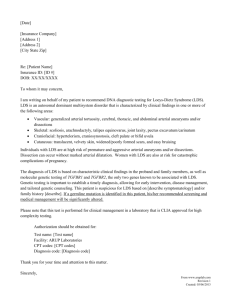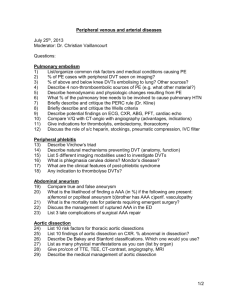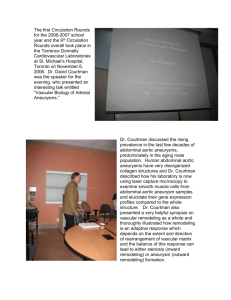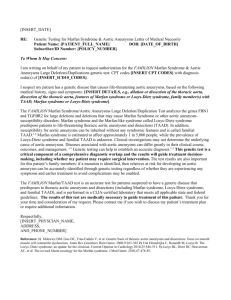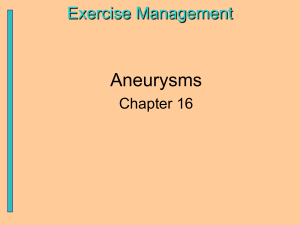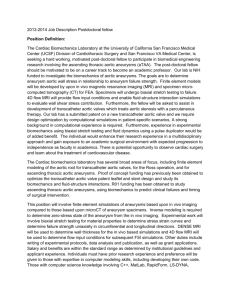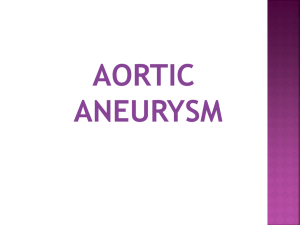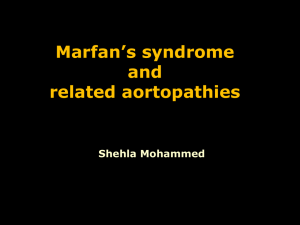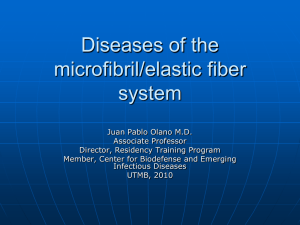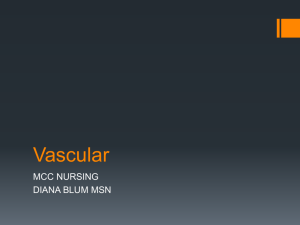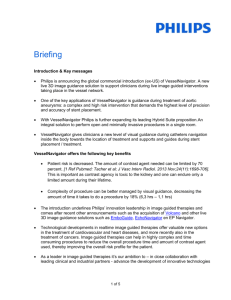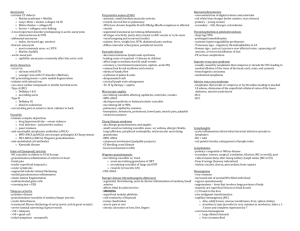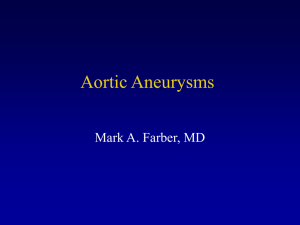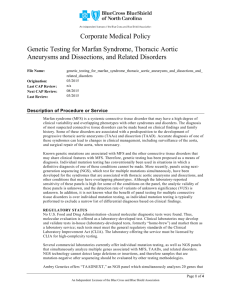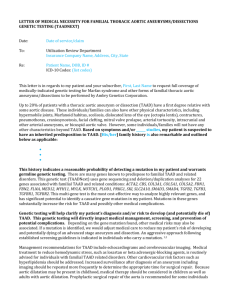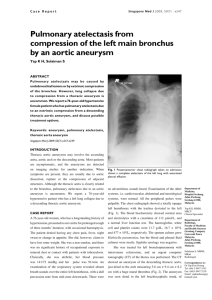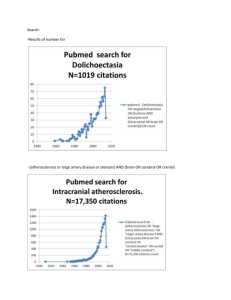Supplementary Appendixes
advertisement
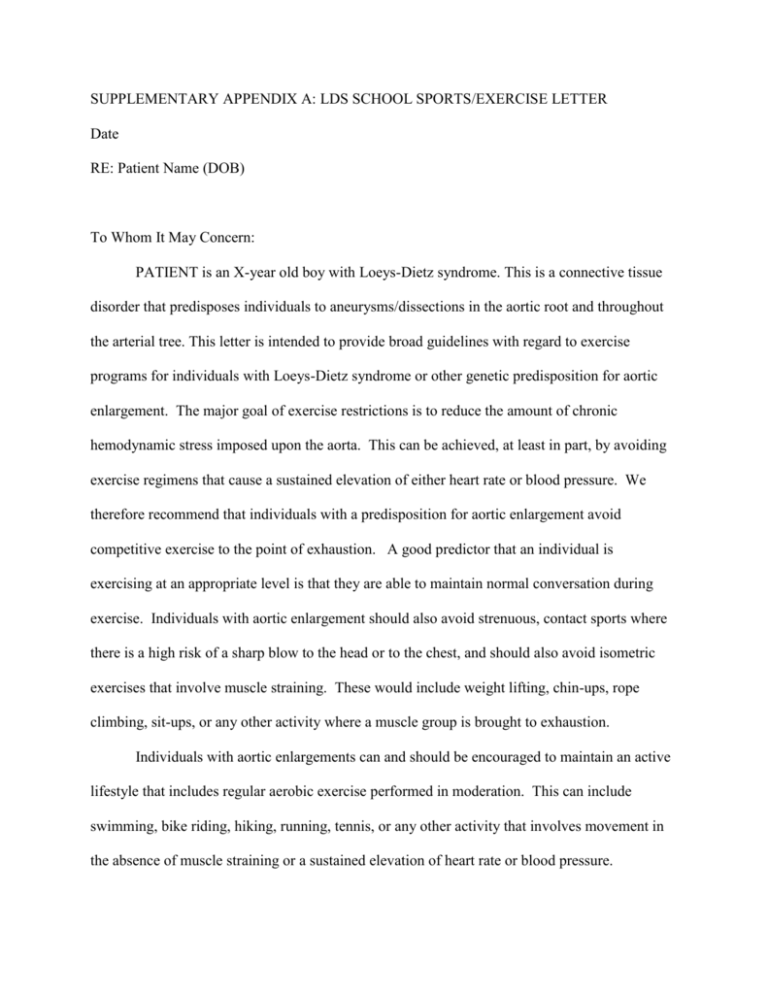
SUPPLEMENTARY APPENDIX A: LDS SCHOOL SPORTS/EXERCISE LETTER Date RE: Patient Name (DOB) To Whom It May Concern: PATIENT is an X-year old boy with Loeys-Dietz syndrome. This is a connective tissue disorder that predisposes individuals to aneurysms/dissections in the aortic root and throughout the arterial tree. This letter is intended to provide broad guidelines with regard to exercise programs for individuals with Loeys-Dietz syndrome or other genetic predisposition for aortic enlargement. The major goal of exercise restrictions is to reduce the amount of chronic hemodynamic stress imposed upon the aorta. This can be achieved, at least in part, by avoiding exercise regimens that cause a sustained elevation of either heart rate or blood pressure. We therefore recommend that individuals with a predisposition for aortic enlargement avoid competitive exercise to the point of exhaustion. A good predictor that an individual is exercising at an appropriate level is that they are able to maintain normal conversation during exercise. Individuals with aortic enlargement should also avoid strenuous, contact sports where there is a high risk of a sharp blow to the head or to the chest, and should also avoid isometric exercises that involve muscle straining. These would include weight lifting, chin-ups, rope climbing, sit-ups, or any other activity where a muscle group is brought to exhaustion. Individuals with aortic enlargements can and should be encouraged to maintain an active lifestyle that includes regular aerobic exercise performed in moderation. This can include swimming, bike riding, hiking, running, tennis, or any other activity that involves movement in the absence of muscle straining or a sustained elevation of heart rate or blood pressure. If these accommodations cannot be made, it is imperative that PATIENT be allowed to take another course in place of the PE class, as sitting on the sidelines is not an acceptable alternative. Please feel free to contact our office with any further questions or concerns. Sincerely, CARE PROVIDERS SUPPLAMENTARY APPENDIX B: LDS SCHOOL LETTER EXAMPLE DATE RE: PATIENT (DOB) To Whom It May Concern, PATIENT has been diagnosed with Loeys-Dietz syndrome. This is a connective tissue disorder that is characterized by specific physical features that can include craniosynostosis (premature fusion of the skull bones), skeletal findings including scoliosis (curvature of the spine), joint laxity, clubfoot, and skin findings including easy bleeding and bruising and abnormal wound healing. Most importantly, it is found that individuals with Loeys-Dietz syndrome have a predisposition to widening or dilations (aneurysms) of the arteries. This is most often seen in the aortic root, but dilations can be seen throughout the arteries of the body. Individuals with Loeys-Dietz syndrome are at significant risk for dissections and ruptures of arteries. These vessels can rupture at sizes not previously thought to be dangerous for the general population or for those with other connective tissue disorders. PATIENT is monitored through serial echocardiograms and other imaging techniques for aneurysm formation. PATIENT is on blood pressure medication, NAME OF MEDICINE, to help prevent or slow future aneurysm growth. Intestinal and uterine ruptures have also been seen as rare complications of Loeys-Dietz syndrome. If PATIENT presents to a teacher or school nurse with significant pain, dizziness, loss of consciousness, shortness of breath, difficulty breathing or speaking, vision disturbance or severe headache, we ask that she be given prompt attention, as these may be signs of vascular tears. Her parents should be notified and emergency services may need to be considered. Abrupt loss of vision may also be a sign of retinal detachment and also needs immediate ophthalmological investigation. STATEMENT ABOUT PHYSICIAN CONTACT INFORMATION IN CASE OF EMERGENCY OR QUESTIONS. As well, a few other considerations for PATIENT’S schooling may need to be considered: 1. Food allergies are common in Loeys-Dietz syndrome, and PATIENT has allergies to LIST. If PATIENT is exposed to the allergen, please assess level of reaction, treat with antihistamine if necessary, and consider EPI-PEN only in cases of life-threatening allergic reactions. 2. Learning problems are not a typical finding in Loeys-Dietz syndrome. However, due to joint laxity, some individuals may have some increased difficulty with balance and fine or gross motor skills. 3. Children with connective tissue disorders sometimes benefit (especially at older ages) of having two sets of books, one at school and one at home, so that they do not have to carry a heavy set of books in a backpack, which may impact scoliosis management. 4. In terms of exercise restrictions, we do recommend that PATIENT remain active in gym class with cardiovascular activities. However, we do recommend that he/she not participate in contact or competitive sports, isometric exercises or exercises/activities performed to the point of exhaustion. Because of the complexity of PATIENT’s genetic condition, he/she may have more absences from school due to medical appointments than other children. We hope that you will be understanding of these absences. As children age, they become more cognizant of their physical or medical “differences.” If the school notices any change in behavior or interactions with other students, it’s important that the family be notified, so that we can all work together in helping PATIENT understand and accept his/her genetic condition, and to fully enjoy and engage with others in his/her school setting. We would be happy to answer any additional questions or concerns that you may have. Please do not hesitate to contact our office at X. Sincerely, CARE PROVIDERS SUPPLEMENTARY APPENDIX C: LDS EMERGENCY LETTER EXAMPLE DATE RE: NAME (DOB) To Whom It May Concern, PATIENT has been diagnosed with Loeys-Dietz syndrome (LDS).This is a connective tissue disorder that presents clinically with a predisposition to spontaneous aortic, arterial or hollow organ rupture. The most common site of aneurysm or dissection is at the aortic root, however, aneurysms and dissections throughout the arterial tree (head, neck, chest, pelvis, abdomen) can occur. In patients with LDS, rupture of any artery into a free space is lifethreatening and requires immediate intervention. Vascular surgery is typically well-tolerated. Additionally, there may be no prior documentation of a pre-existing aneurysm as vessels can rupture at sizes not previously thought to be dangerous for the general population or for those with other connective tissue disorders. If this individual presents with significant abdominal, chest or other pain, dizziness, loss of consciousness, shortness of breath, difficulty breathing or speaking, vision disturbances or severe headaches, we ask that he/she be given prompt medical attention and that radiological investigation for arterial/organ rupture or tear be initiated. DESCRIBE CURRENT VASCULAR STATUS IF PATIENT HAS KNOWN ANEURYSMS. Abrupt loss of vision may also be a sign of retinal detachment and needs immediate ophthalmological investigation. Some individuals with LDS have cervical-spine instability. In the most severe cases, this has usually been addressed with cervical fusion. If previous records are not available, we recommend using c-spine precautions with intubation for surgical intervention. STATEMENT ABOUT PHYSICIAN CONTACT INFORMATION IN CASE OF EMERGENCY OR QUESTIONS. Sincerely, CAREGIVERS
